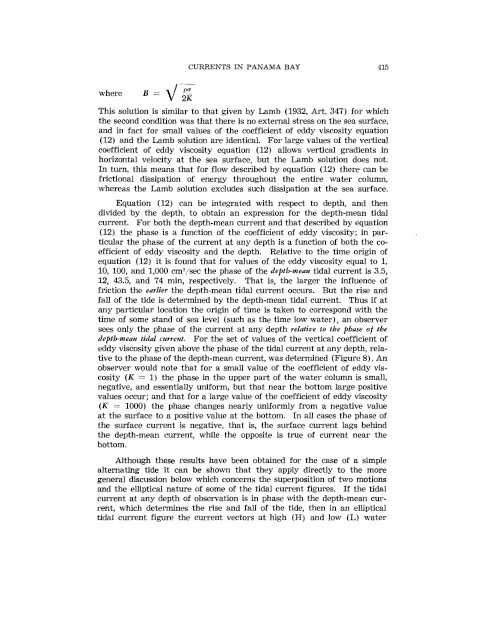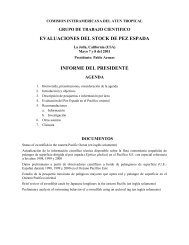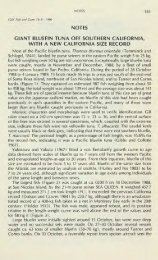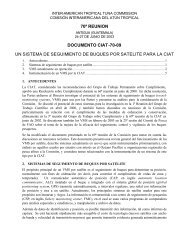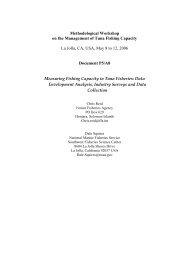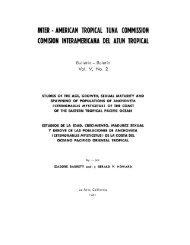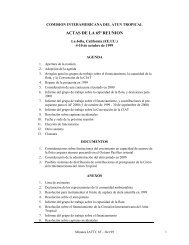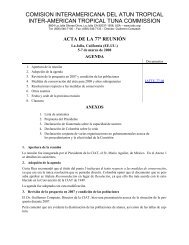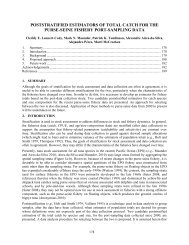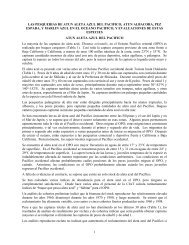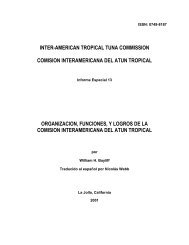t - Comisión Interamericana del Atún Tropical
t - Comisión Interamericana del Atún Tropical
t - Comisión Interamericana del Atún Tropical
- No tags were found...
Create successful ePaper yourself
Turn your PDF publications into a flip-book with our unique Google optimized e-Paper software.
CURRENTS IN PANAMA BAY415whereB = V~R-This solution is similar to that given by Lamb (1932, Art. 347) for whichthe second condition was that there is no external stress on the sea surface,and in fact for small values of the coefficient of eddy viscosity equation(12) and the Lamb solution are identica1. For large values of the verticalcoefficient of eddy viscosity equation (12) allows vertical gradients inhorizontal velocity at the sea surface, but the Lamb solution does noteIn turn, this means that for flow described by equation (12) there can befrictional dissipation of energy throughout the entire water column,whereas the Lamb solution excludes such dissipation at the sea surface.Equation (12) can be integrated with respect to depth, and thendivided by the depth, to obtain an expression for the depth-mean tidalcurrent. For both the depth-mean current and that described by equation(12) the phase is a function of the coefficient of eddy viscosity; in particularthe phase of the current at any depth is a function of both the coefficientof eddy viscosity and the depth. Relative to the time origin ofequation (12) it is found that for values of the eddy viscosity equal to 1,10, 100, and 1,000 cm 2 /sec the phase of the depth-mean tidal current is3.5,12, 43.5, and 74 min, respectively. That is, the larger the influence offriction the earlier the depth-mean tidal current occurs. But the rise andfall of the tide is determined by the depth-mean tidal current. Thus if atany particular location the origin of time is taken to correspond with thetime of sorne stand of sea level (such as the time low water), an observersees only the phase of the current at any depth relative to the pbase o/ thedepth-mea'n tidal current. For the set of values of the vertical coefficient ofeddy viscosity given above the phase of the tidal current at any depth, relativeto the phase of the depth-mean current, was determined (Figure 8). Anobserver would note that for a small value of the· coefficient of eddy viscosity(K == 1) the phase in the upper part of the water column is small,negative, and essentially uniform, but that near the bottom large positivevalues occur; and that for a large value of the coefficient of eddy viscosity(K == 1000) the phase changes nearly uniformly from a negative valueat the surface to a positive value at the bottom. In all cases the phase ofthe surface current is negative, that is, the surface current lags behindthe depth-mean current, while the opposite is true of current near thebottom.Although these results have been obtained for the case of a simplealternating tide it can be shown that they apply directly to the moregeneral discussion below which concerns the superposition of two motionsand the elliptical nature of sorne of the tidal current figures. If the tidalcurrent at any depth of observation is in phase with the depth-mean current,which determines the rise and fall of the tide, then in an ellipticaltidal current figure the current vectors at high (H) and low (L) water


